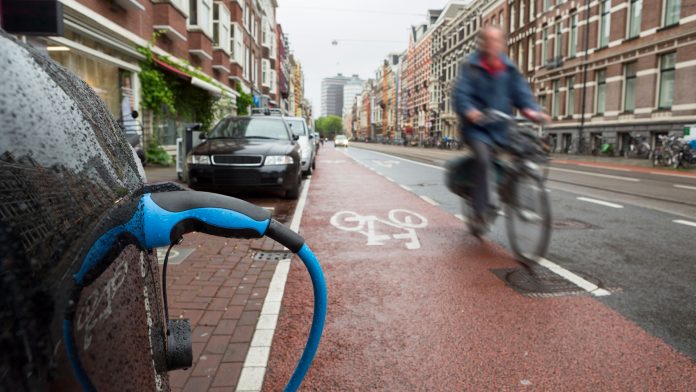André ten Bloemendal, Vice President, Europe at ChargePoint, explains why going green and reducing commuter emissions is about changing, not just replacing, our existing approach to transport.
Transportation is one of the major sources of greenhouse gas emissions worldwide. Reducing greenhouse gas (GHG) emissions from transportation is key to slowing climate change and making sure our planet stays a healthy place to live. Driving an electric vehicle (EV) can cut fossil fuel emissions in half – or get rid of them entirely when renewable energy sources are used.
Irrespective of how the electricity is generated, EVs drastically improve air quality, particularly in urban areas where there are high concentrations of vehicles moving at slower speeds, resulting in a more urgent need to reduce commuter emissions. They offer a clear avenue to decarbonise the transport sector, but some people have pointed out that merely replacing the total number of vehicles we have now with EVs is not sustainable in the long term.
Former cycling champion Chris Boardman has argued that they are one of the biggest barriers to solving congestion and pollution caused by reliance on private vehicles; saying that for him, cycling offers the best alternative.
Our European headquarters being based in Amsterdam, we at ChargePoint are certainly no strangers to cycling; with most of our office commuting by bike. Data shows there are significant benefits from this form of transport for the environment. According to the European Cyclists’ Federation (ECF), a car releases an average of 433g of CO2e (carbon dioxide equivalent) per passenger mile. A cyclist will release just 26g in emissions (created in the production of the food that fuels the rider).
If the whole of Europe matched the level of cycling per day seen in Denmark, the ECF calculates that by 2050 we would reach 12% to 26% of the EU’s emissions reduction target.
While this is certainly something to be aimed for, even with the best of intentions it is not feasible. There are many reasons why temperate, flat and relatively small Denmark has the cycling culture it does. Recreating this for the commuters of the valleys of the Alps or commuters travelling over 50 miles to London every day is not realistic.
So, what can be done then to lessen their climate impact?
The right infrastructure in the right place
Today, more than half of the earth’s 7.3 billion people live in cities. By 2050, it will be over two thirds. A rising population means greater strains on existing infrastructure, including more congestion on roadways and increased air and noise pollution.
To transport these people sustainably, EVs offer the easiest way to lower GHG emissions. To ensure wider EV adoption, the right charging infrastructure is needed. With most cars spending 95% of their time parked, charging where they are parked most, either at home or at work, is the natural choice. For substantial adoption to take place, regulation through clear and ambitious building codes to facilitate the installation of such infrastructure needs to take place.
Ensuring that drivers are not only able to find a place to charge, but are able to use the charger regardless of whether they are a member of its company, is key to adoption. ‘Roaming’ between all charging stations at no extra cost to the driver will be crucial to optimise uptake of EVs. Upcoming revision of the EU’s Alternative Fuels Infrastructure directive will also be crucial in creating a regulatory framework for e-mobility services.
Congestion
EVs will clearly contribute to reducing commuter emissions, local pollution (GHG and particles) and noise, but EVs themselves do not particularly address congestion. Multimodal transport will clearly be the future for moving around in urban environments. This can entail cycling as Boardman suggests, but even in Amsterdam on a stormy day people quickly abandon their bikes.
Electric buses offer a real solution. Buses are predictable and prevalent, which makes electrifying them an excellent choice for communities seeking to accelerate sustainability. As such, they have already attracted significant public funding across Europe. Ensuring that the infrastructure, in this case DC fast charging solutions, is again key. These systems offer power management features, so fleet managers can schedule charging during off-peak hours to avoid expensive ‘demand charges’.
Cities benefit due to the cost savings associated with EV fleets; utilities win because they have more control over the electricity supply and citizens benefit from reduced commuter emissions, air and noise pollution.
Ensuring that there is significant availability of short term lease electric vehicles in our cities is another way to help reduce congestion, giving regular cyclists or users of public transport options when their usual routine is altered and bringing down total car ownership. We should adopt more car share services like ShareNow, which offer the ability to drive electric vehicles for as little as a few minutes. Electric taxis have also proven effective at reducing car ownership and local pollution. They are now available in most major cities; and in London we have developed an innovative charging solution for taxi drivers which gives them discounted charging on our publicly available chargers in central London locations. Ensuring the availability of sufficient and well-placed DC and AC chargers is integral to this solution.
To wrap up, Boardman is correct to state that if we simply replace all existing vehicles with EVs we are not truly addressing our transport problems. However, EVs do offer the best available option for reducing our carbon footprint in a realistic way that does not require fundamental limitations to mobility or significant societal or economic change. By putting in place the right charging infrastructure now, we can make sure that public transport, car sharing and other shared forms of transport can be quickly electrified, ensuring that people are able to not only reduce their carbon footprint, but help in reducing commuter emissions, localised pollution and congestion in all our cities.
André ten Bloemendal
Vice President, Europe
ChargePoint







